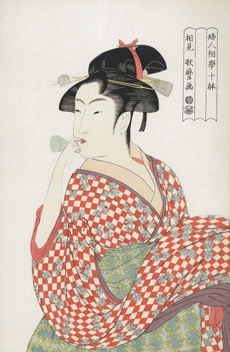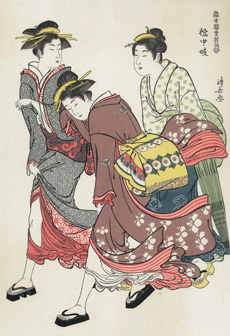- When was Ukiyo-e BornOpen or Close
The word “ukiyo-e” is in “Sorezore-gusa” that is a book of poems called haikai-bon. It seems that this is the oldest record of the word “ukiyo-e”. But ukiyo-e at that time was not same as the one we know now. Besides hand drawing ukiyo-e, it was treated as illustrations in reading “yomimono”. Furthermore, the color was black only (with sumi black ink). The reading yomimono was called “ukiyo-zōshi” and read many people because the contents with a red-light district or theater play were favorably well received. A typical ukiyo-zōshi is “Kōshoku Ichidai Otoko” by Ihara Saikaku, published in 1682 in Osaka and Tokyo at the same time. And the one who draw illustration for Tokyo version was Hishikawa Moromobu who is said as the founder of ukiyo-e. Moronobu was born in Chiba prefecture and moved to Edo when he was twenty. He worked very hard in Edo and got his original style of drawing. E-tehon “Buke Hyakunin Isshu” was published with his autograph. There were other illustrations but it was said that he is the first man whose name was published on individually. From 1670 to 1680, one piece of ukiyo-e that is not a piece of illustrations was created. After that, an ukiyo-e colored with writing brush was beginning to appear on the market.
- What Ukiyo-e Draw AboutOpen or Close
The towns people who lived in Edo were the ones who bought ukiyo-e. Ukiyo means “the vogue at the present time” and they wanted the ukiyo-e whose subjects were amusing customs like the life style of red-light district, actors, beauty of the town, famous place or historic sites. But the subjects of ukiyo-e were not only about the customs but also the vivid life style of the ordinary people or themselves. The shun-ga (erotic ukiyo-e) “Teishō no Nochi/Ato” (After a Tune) which was created by Hishikawa Moronobu is a set of 12 pieces of ukiyo-e that is about a red-light district. It conveys delicate and tender feelings between man and woman with the expressions with hands, feet and other physical details or small materials like kimono or shamisen (three-stringed Japanese banjo). And on the hand-drawing master piece “Mikaeri Bijin”, not only the hair style or clothes popular at that time but also the dignified disposition or air of woman are expressed greatly by Moronobu.
These traditions of ukiyo-e that subject on ordinary people or their life style were alive in Meiji, Taishō and Shōwa period. On 19th century, they influenced European drawings and now get high valuation from all over the world as the one that express the uniqueness of Japanese beauty.
- The Development of Ukiyo-e and Edo PeriodOpen or Close
Ukiyo-e is imaged as a printing. But until the mass-production with woodblock, hand drawing was the main way of production, like byōbu-e (folding screen), emaki (picture scroll) or kakejiku (hanging scroll). The ukiyo-e by woodblock prints were started to be increased after the big fire broke out in Edo in 1657. For the reconstruct from the big fire, a large number of people from all over the country flowed in Edo and Edo became more active than ever before. When an economic grows up, people tends to want amusements, entertainments, cultivations or educations. Under those circumstances, ukiyo-e was developed as woodblock prints. And by the prosperity of woodblock prints, hanmoto (who publish woodblock prints) was powered than before. Hanmoto got to have a great influence on e-shi (paint artist) to create a good seller.
In 1670’s, ukiyo-e were produced with black color only called sumi-zuri-e. After 50 years from that time, the skills called tan-e (colored by hands with writing brush, yellow and red only) or beni-e (colored by hands with writing brush, a few colors mainly red) were developed. The art works by Hishikawa Moronobu who is the master of the beginning of ukiyo-e were created at this time. In 1750’s, the skill called beni-zuri-e was started to be used. This is the skill put red, blue, green and yellow on black sumi woodblock print and herald of nishiki-e (ukiyo-e that were produced by multiple colored prints).
In 1765, ukiyo-e that we know very well now were started to be created for egoyomi-koukankai held by rich people. At that time, people used the lunar calendar unlike the solar calendar that we use today. Then they needed to change the calendar for month and dilettanti enjoyed to create his original ukiyo-e calendar and exchange it among companions. They competed each other at the points of the choice of subject, the sense of color, composition or so on. As the result, not only the design of ukiyo-e but also the skills of hori (carving) or suri (printing) were developed rapidly. The artist who was on the rise by the vogue of egoyomi-koukankai was Suzuki Harunobu. By nishiki-e, the strong producing structure with e-shi, hori-shi (who carve woodblock), suri-shi (who print ukiyo-e) and hanmoto was established and ukiyo-e had been produced gorgeously beyond the times after that.

Kitagawa Utamaro
“Hujin Sōgaku Jittei Poppī wo Huku Musume”
Torii Kiyonaga
“Tousei Yūri Bijin Awase Tachibana”
Nishiki-e which was established in the middle of 18th century got to be at the zenith of it’s prosperity from the second half of 18th century to 19th century by the developments of the quality of paper, the materials like colors, the skills of hori or suri . The great paint artists like Katukawa Shunshō who is the master of Katushika Hokusai, Utagawa Toyoharu who is the founder of Utagawa school, Kitagawa Utamaro, Torii Kiyonaga or Tōshūsai Sharaku appered and produced high quality art works like bijin-ga (ukiyo-e of beautiful woman) or yakusha-e (ukiyo-e of actor). The vague at that time was ookubi-e which is a portrait drawing the bust. Katukawa Shunshō produced ookubi-e with high realistic and got the talk at that time. Utamaro, Sharaku and the artists of Utagawa school were followed this movement and produced many ookubi-e.
